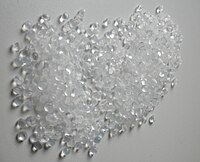
Photo from wikipedia
Abstract Injection moulded composite materials reinforced with wood fibres or particles can offer a credible alternative to other plant-derived fibres, particularly from an economic and environmental point of view. In… Click to show full abstract
Abstract Injection moulded composite materials reinforced with wood fibres or particles can offer a credible alternative to other plant-derived fibres, particularly from an economic and environmental point of view. In this study, we compared the recycling behaviour of poly-(propylene) composites reinforced with ground wood particles versus wood and flax fibre reinforced composites. An experimental and numerical approach was used. In spite of the mechanical and morphological performances of fibres which were initially poorer than those of long fibres, the wood particles demonstrated their reinforcement potential (+84 % and +14 %, for the Young’s modulus and the strength at max, respectively, compared to the pure matrix), due to their good adhesion with the matrix and also to the stability of their aspect ratio after recycling (-24 % after 5 injection cycles against -66 % and -61 % for long flax and wood fibres, respectively). The numerical model developed and fed by the mechanical and morphological measurements carried out on the reinforcements made it possible to compare the experimental and numerical values. Overall, a close match was obtained between the two sets of parameters. The small differences obtained can be explained by the increase in fibre dispersion as the recycling process progresses, as well as by the possible increase in wood stiffness after several processing cycles.
Journal Title: Industrial Crops and Products
Year Published: 2021
Link to full text (if available)
Share on Social Media: Sign Up to like & get
recommendations!